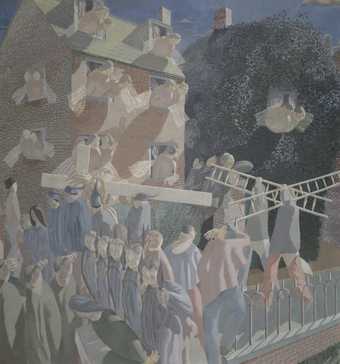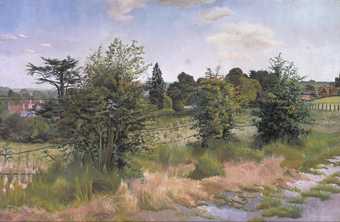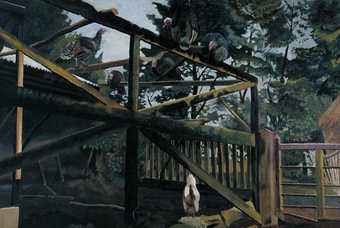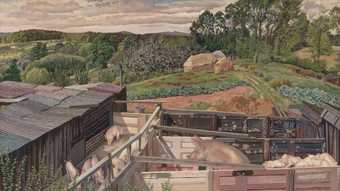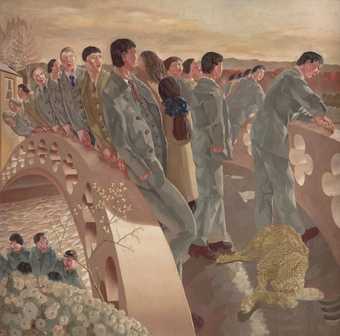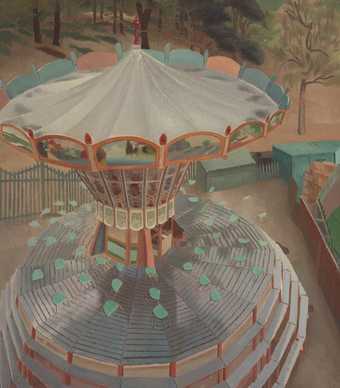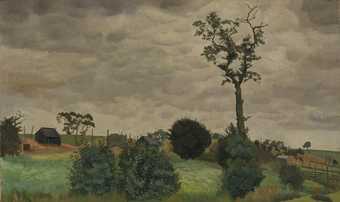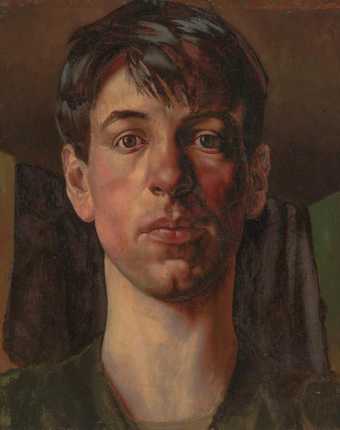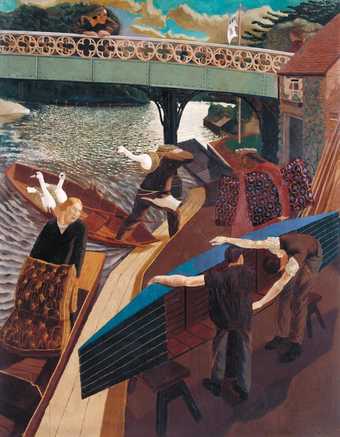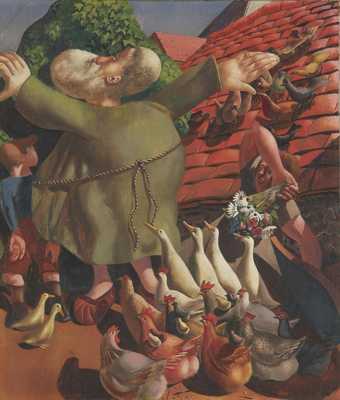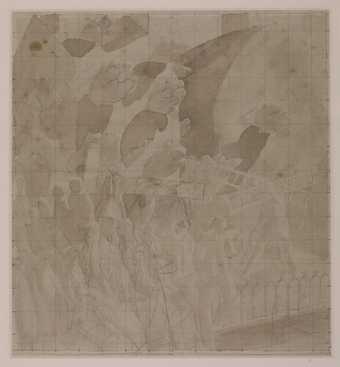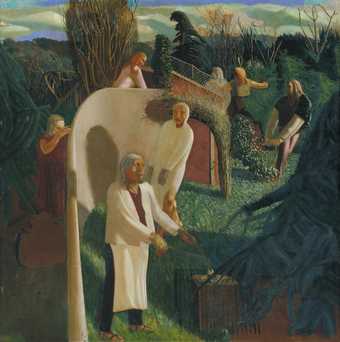
Not on display
- Artist
- Sir Stanley Spencer 1891–1959
- Medium
- Oil paint on canvas
- Dimensions
- Support: 2743 × 5486 mm
- Collection
- Tate
- Acquisition
- Presented by Lord Duveen 1927
- Reference
- N04239
Display caption
As a devout Christian, Spencer believed in a joyful day of resurrection. Everyone would be raised from the dead to receive judgement or glory. Here he depicts this taking place in the churchyard of Cookham, the Berkshire village where he lived. God and Christ watch as people emerge from their graves. Most of the white people are local friends or specific biblical figures. By contrast, Spencer represents the group of Black people at the centre of the painting in a generalising way. They are not based on people he knew, but on images he saw in National Geographic magazine.
Gallery label, December 2022
Does this text contain inaccurate information or language that you feel we should improve or change? We would like to hear from you.
Catalogue entry
N04239 THE RESURRECTION, COOKHAM 1923–7
Not inscribed.
Canvas, 108×216 (274×549).
Presented by Lord Duveen 1927.
Coll: Purchased by the Duveen Paintings Fund Committee from the artist through the Goupil Gallery 1927.
Exh: Goupil Gallery, February 1927 (54), as ‘The Resurrection’; Tate Gallery, November–December 1955 (25).
Lit: Connoisseur, LXXVII, 1927, pp.250–1; ibid., LXXVIII, 1927, pp.98–101, 185–6; Drawing and Design, II, 1927, p.105, repr. p.115; Johnson, 1932, pp.331–2; Chamot, 1937, p.74; Studio, CXXVI, 1943, p.50, repr. p.51; Rothenstein, 1945, p.14, repr. pls.21–4; John Rothenstein, Modern English Painters: Lewis to Moore, 1956, pp.181–2; Spencer, 1961, pp.172, 174–6; Collis, 1962, pp.77, 80–9, 91, 143, 162, 193, 243.
Repr: R. H. Wilenski, The Modern Movement in Art, 1927, pl.4; Newton, 1947, pl.9 (in colour).
The setting is Cookham churchyard with the Thames in the background. God the Father and Christ with the little children are seen under the porch in the centre; several ‘thinkers’, including Moses, are near by. Both black and white people have been included to make the treatment as universal as possible. The artist is seen reclining on a tombstone in the bottom right-hand corner, and again, naked, head in profile to the right, close to the porch. His wife Hilda is in the overgrown grave in the foreground; she also appears smelling a flower on the left; in the distance she is seen a third time climbing a stile which leads to the River of Life. The figure rising from the flowered grave in the foreground is a memory of Sir Henry Slesser in his judge's wig. The bad emerge from their graves with some difficulty and are shepherded into the corner of their tombs. To the left people read the inscription on their own tombstones and help each other to spruce up. The impression is one of great peace and joy. The artist thought the picture might serve as an altarpiece.
A detailed drawing for the above composition (probably that exhibited at the Goupil Gallery, 1927 (20), as ‘Original Composition for the Resurrection’, bought by Lady Sybil Smith) was made while staying with Henry Lamb at Poole in 1922–3, and the painting itself was executed in Henry Lamb's studio in London (3 Vale Hotel, Vale of Health, Hampstead). The date of completion is usually given as 1926, but the artist thought that he was still working on it at the beginning of 1927. Certain ideas for ‘The Resurrection: Cookham’ were fore-shadowed by the pair of paintings ‘The Resurrection of the Good and Bad’ completed in 1913, of which the artist wrote (1949, see exh. cat., Tate Gallery, 1955, Nos.9 and 10): ‘I love the Revelations and all it says but when I did the first biggish paintings of “The Resurrection”, in 1913, the punishment of the Bad was to be no more than that their coming out of the graves was not so easy as in the case of the Good.’
A pencil and wash study of negroes for N04239 was lent by Mrs Basil Gray to the Arts Council exhibition, 1955 (30). An oil sketch of the pleasure boat in the top left-hand corner belongs to Sir Henry Slesser.
Published in:
Mary Chamot, Dennis Farr and Martin Butlin, The Modern British Paintings, Drawings and Sculpture, London 1964, II
Explore
- architecture(30,960)
- townscapes / man-made features(21,603)
-
- graveyard(205)
- religious and ceremonial(1,733)
-
- gravestone / tomb(318)
- black(796)
- self-portraits(888)
- UK cities, towns and villages(12,725)
- Berkshire(746)
- England(19,202)
- England, South East(5,940)
- England, Southern(8,982)
- River Thames(731)
- Bible: New Testament(545)
-
- Christ(281)
- Moses(26)
- God(152)
- resurrection(30)
- prophet(7)
- arts and entertainment(7,210)
-
- artist, painter(2,545)
You might like
-
Sir Stanley Spencer Christ Carrying the Cross
1920 -
Sir Stanley Spencer Terry’s Lane, Cookham
c.1932 -
Sir Stanley Spencer Turkeys
1925 -
Sir Stanley Spencer Rickett’s Farm, Cookham Dene
1938 -
Sir Stanley Spencer The Bridge
1920 -
Sir Stanley Spencer The Roundabout
1923 -
Sir Stanley Spencer The Resurrection: Port Glasgow
1947–50 -
Sir Stanley Spencer Tree and Chicken Coops, Wangford
1925 -
Sir Stanley Spencer Self-Portrait
1914 -
Sir Stanley Spencer Swan Upping at Cookham
1915–19 -
Sir Stanley Spencer Mending Cowls, Cookham
1915 -
Sir Stanley Spencer St Francis and the Birds
1935 -
Sir Stanley Spencer Turk’s Boatyard Cookham
c.1931 -
Sir Stanley Spencer Study for ‘Christ Carrying the Cross’
1920 -
Sir Stanley Spencer Zacharias and Elizabeth
1913–14

